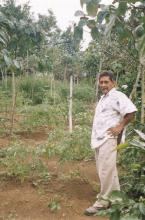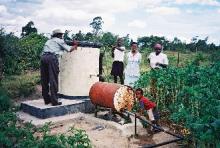Technology
02. A multi sectoral approach to sustainable rural water supply: the role of the rope handpump in Nicaragua
J.H.Alberts and J.J. van der Zee (2004)
A low cost rope handpump for boreholes and hand-dug wells up to 70 m deep has been developed, marketed, and subsequently mass-produced in Nicaragua by local, small, privately-owned workshops since the early 1990’s. It is easy to maintain and highly efficient at the family- as well as community level.
The pump has met with high social acceptance amongst rural users ever since the early, rudimentary models were first made available. By 1995 the technology became an integral part of rural water programmes implemented by NGOs and government agencies. Rural water supply coverage since then has doubled from approximately 27.5% to 54.8%. Of this 27.3 percentage point rise, rope pumps account for 23.6% (or 85% of the total increase).
The income generating capacity of the rope pump has been an important reason for its acceptance and successful introduction. In addition credit schemes linked to the introduction of the pumps have proven successful, whilst comparative studies of farm income show that families with a rope pump generate an average US$225 of additional annual income which can represent up to 50% of the total income for the lower income groups.
Production of the technology by about a dozen private workshops has made Nicaragua the country with the highest handpump density per rural capita. Though broad international interest has been received, inclusion of the technology in rural water supply programmes on other continents has encountered serious institutional barriers. Widespread introduction elsewhere requires a multi sectoral approach in a context somewhat broader than the policies of the traditional Water and Sanitation sector. In particular, the impact of income generation on sustainability should be understood and capitalised on, whilst alliances with the private sector are required for promotion and production. Collaboration across boundaries between poverty reduction initiatives and the water supply sector are fully justifiable.
However, symbiosis between the private sector user and private sector producer is the essential foundation to make development an economically viable proposition.
Entitled 'Recognizing reality: multiple use of rural water supply systems', this case study documents the experience of some areas in Cali in meeting the multiple demand and need for water in rural areas. The study is entered into with an understanding that there is a strong demand for small-scale productive use of water and that all too often, water supply systems are designed to only meet domestic demands. Based on the findings of the case study, experiences in Cali reflect the importance of developing integrated solutions to people's water needs and the push for institutional innovation and design to bridge the needs of the reproductive and productive domains.
This case study provides an overview of the work and key interventions made by the NGO Pump Aid at the household (HH) and community levels in some parts of Zimbabwe. Prepared by Ian Thorpe, the case study entitled 'Appropriate technology for sustainable water systems in Zimbabwe', succintly discusses the technological approach adopted by the NGO (i.e. elephant pump) in providing communities with reliable access to clean, safe water for drinking and irrigation; the participatory approaches that are at the crux of its work and the success of the project; and its application of multiple/productive use of water.


